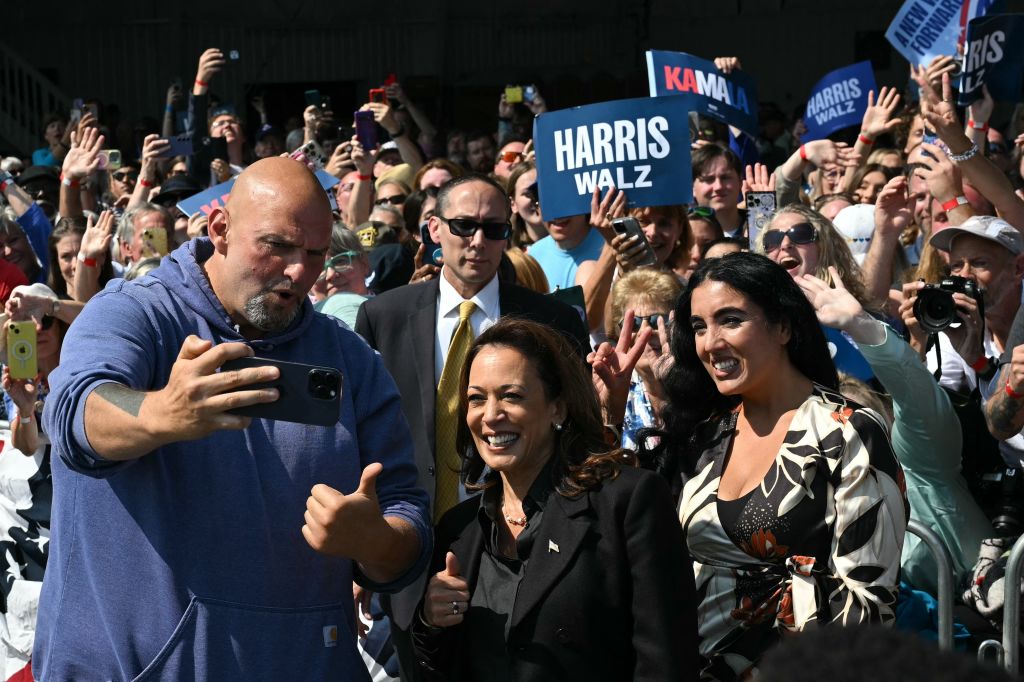
We continue this week in this note’s obsessive focus on undecided and highly persuadable voters. But I am unashamed. If we devoted the next seven editions before Election Day to that little sliver of the electorate—maybe just 6 percent—it wouldn’t be too much.
In the campaign before July 21, when President Joe Biden dropped out, we were talking about a lower turnout affair with lots of folks throwing up their hands at their choices and staying home. It would have been a base vs. base election not unlike 2016, and one in which highly motivated diehard fans of former President Donald Trump did battle with equally ardent foes of the former president. That was a race that Trump was favored to win.
But that’s not the race we have now. If you want evidence, just check the ratings. Some 67 million people watched the debate between Trump and Vice President Kamala Harris this week, almost 16 million more than watched Biden’s meltdown in June. We could explain some of that by the fact that television viewership is generally lower in the summer, but not all of it.
We may not match the historically high turnout of 2020 when COVID and a summer of unrest focused public attention on the contest in intense and often unhelpful ways, but we are definitely seeing the electorate grow before our eyes.
America is tuning in to this race, and that means lots of lower propensity voters are joining the fray. This is the third of the electorate that typically doesn’t show up in midterm years but may make the effort in quadrennial contests. And what we know about them is that they also tend to be less reliably partisan and less ideological.
Campaigns are very good at getting low-propensity voters from their own sides engaged—that’s what all that door knocking is about. It’s not persuasion, it’s mobilization. But if you see the electorate grow beyond the 140 million voter mark—for reference, there were 137 million voters in 2016 and 159 million voters in 2020—that’s organic interest.
So let’s say we land in the middle of the previous two cycles and have 148 million ballots cast this year. You’d already have 66 million Democratic votes in the bank and 63 million Republicans. What about the other 19 million? Those are the folks who will decide the election.
So what will become of these visitors to the burned-over country of political engagement where the rest of us reside?
You’ll see in the Statshot below the last look at the race before the effects of the doozy of a debate that took place this week. The average includes just one poll taken after the debate, a two-day survey conducted for Reuters on Wednesday and Thursday of this week. This is not my favorite pollster, but it meets our methodological standards. The poll shows Harris up 5 points on Trump, but only getting 47 percent of the vote to Trump’s 42 percent. That would leave 11 percent up for grabs or voting for a protest candidate. Not much different from their poll in late August.
In a week’s time that one wispy poll will be joined by other, stouter surveys. But for now, we get a glimpse of the race mostly as it was before Trump and Harris met for the first and maybe only time this campaign. And the race was going the wrong way for Democrats. This week’s average puts Harris up 2.2 points nationally, which would put her almost exactly where Hillary Clinton was in 2016: On the wrong side of the swing state shift.
Now think about our 19 million lower propensity voters. How many of them reached a decision this week? And of that number of deciders, how did they break?
This week and every week until November 5, remember those 19 million as they pass through the turnstiles of decision. Major events accelerate the pace as they provide cues to voters that the time has come to choose, but so does the day-in-day-out grind of news coverage, political events, and a constant barrage of advertising that will only intensify, hour by hour, for each of the next 52 days.
Holy croakano! We welcome your feedback, so please email us with your tips, corrections, reactions, amplifications, etc. at STIREWALTISMS@THEDISPATCH.COM. If you’d like to be considered for publication, please include your real name and hometown. If you don’t want your comments to be made public, please specify.
STATSHOT
General Election
Kamala Harris: 48.4% (↓0.2 points from last week)
Donald Trump: 46.2% (↑ 0.6)
[Average includes: Ipsos/Reuters: Trump 42% - Harris 47%; NYT/Siena: Trump 48% - Harris 47%; Maris/NPR/PBS: Trump 48% - Harris 49%; Emerson College: Trump 48% - Harris 51%; TIPP: Trump 45% - Harris 48%]
Generic Ballot
Democrats: 46.2% (↓ 0.4 points from last week)
Republicans: 43.8% (↓ 0.2)
[Average includes: Marist/NPR/PBS: 46% Democrats - 45% Republicans; Emerson College: 48% Democrats - 44% Republicans; Suffolk/USA Today: 48% Democrats - 43% Republicans; Wall Street Journal: 47% Democrats - 46% Republicans; Ipsos/Reuters: 42% Democrats - 41% Republicans]
TIME OUT: WHEELING AND DEALING
The New Yorker: “‘The World’s Longest Yard Sale’ was founded in 1987, two years into Ronald Reagan’s second Presidential term, and currently runs for six hundred and ninety miles, from Addison, Michigan, to Gadsden, Alabama. The event is widely known as the 127 Yard Sale, because most of it takes place on U.S. Route 127, which cuts through six states like a lightning bolt. For four days, starting on the first Thursday in August, thousands of people set out their wares. … Professional pickers arrive with box trucks or flatbed trailers and come from as far away as California and France. Regulars book hotel rooms well ahead of time or, ever thrifty, sleep in their vehicles. … A chamber of commerce in Tennessee organizes the 127 and puts out an annual map. Each of the forty-three towns along the route is marked with a small bull’s-eye—Celina and Glencoe and Salvisa and Cedar Knob and Mentone and Pikeville and Pall Mall.”
SENIOR VOTE COULD TIP THE 2024 SCALES
Wall Street Journal: “Surveys suggest that, after a summer of swaying back and forth, those senior voters are up for grabs. They first leaned toward Democrat Joe Biden, then shifted quickly away from him after his disastrous early-summer debate against Trump. With Harris now atop the Democratic ticket, seniors appear closely divided. Taken together, the last two Wall Street Journal national polls show Harris and Trump in a statistical tie among those aged 65 and over. … This cohort reached 55.8 million in 2020, meaning it made up 16.8% of the nation’s total population. By 2050, it is expected to reach 23%. … In every presidential election since 1996, older voters have had the highest turnout of any demographic, and the margin is getting bigger. … There is also a gender gap among older voters, just as there is among younger voters. Older men are more likely to support Trump while older women are more likely to back Harris.”
How the Kamala campaign views the electoral math: CNN: “At a leadership retreat for top aides in Wilmington last week, Jen O’Malley Dillon … ticked through the battleground states and warned them: the vice president still did not have any one sure path to 270 electoral votes. Pennsylvania looks rough, though very possible, by their internal numbers before the debate. North Carolina, disappointing Democrats every election for the last 15 years, is feeling better to them this time around than Arizona, which Biden narrowly won four years ago. Nevada and Georgia both seem possible, though depending on the poll, can take a lot of squinting. Michigan and Wisconsin are looking like the best of the bunch for Harris. … As pumped as Harris aides are about her debate performance earlier this week, they don’t think it changed any of that.”
The Charlotte-sized key to a blue North Carolina: New York Times: “Mecklenburg County, home to Charlotte and its suburbs, is a reliably blue region that, in the 16 years since Mr. Obama’s first and only victory there, just hasn’t been blue enough. … Ms. Harris will visit Charlotte and Greensboro on Thursday in a trip that underlines both her campaign’s increased confidence in their North Carolina prospects and serves as a soft endorsement of her party’s strategy there: run up the score on friendly turf. … Canvassers in Mecklenburg have focused largely on turning out Black and Latino voters as well as the handful of independent and infrequent voters in the area. … Democrats have spent millions on the airwaves in all of North Carolina’s media markets. The party is on track to outspend Republicans by nearly $15 million through November, according to an analysis of ad spending from AdImpact.”
Debate draws 67 million viewers, surging past June mark: NBC News: “The debate stage clash between Vice President Kamala Harris and former President Donald Trump drew an estimated 67.1 million viewers, according to the media analytics company Nielsen. The estimated viewership improved on the ratings for the match-up between Trump and President Joe Biden in late June, which attracted roughly 51.3 million viewers. … Nielsen said more than 6.4 million viewers were ages 18 to 34; another 16.8 million were 35 to 54. But viewers over 55 made up the largest share, with more than 41.3 million tuning in. … The first debate between Trump and Biden in 2020 drew 73.1 million people.”
SHEEHY FAVORED AS TESTER FACES TRUMP ON TICKET
Cook Political Report: “[Sen. Jon Tester] is a venerated survivor, to be sure, but with Donald Trump atop the ticket his time may be running out. Successive public polls have shown Sheehy opening up a small but consistent lead. … GOP Senate sources across the board remain incredibly confident about their chances in Montana and see the race as virtually put away. … Democrats push back that their polling still shows Tester within the margin of error, and that those are exactly the type of close races he’s won before. However…[Tim Sheehy] is still the strongest, best-financed candidate he’s ever faced. … Another key difference from Tester’s previous contests is that the state is no longer as parochial as it once was. … We cannot completely count Tester out, given the close races he’s pulled off in the past, but we can no longer call this race a Toss Up. It moves into the Lean Republican column.”
Poll: Dems holding strong in Rust Belt battlegrounds. CBS News: “Democratic Rep. Elissa Slotkin is leading former GOP Rep. Mike Rogers by seven points. Meanwhile, Sens. Bob Casey of Pennsylvania and Tammy Baldwin of Wisconsin are ahead in their reelection bids by seven points and eight points, respectively. … Casey and Baldwin currently lead among independents, who are more or less evenly divided between Democratic nominee Kamala Harris and GOP nominee Donald Trump in the presidential race. And while Republican voters are backing their party nominees in large numbers in all three states, GOP Senate candidates are still running behind Trump among them. That both explains their current deficits and also suggests there's room to grow.”
Alsobrooks leads, but Hogan within striking distance: The Hill: “Prince George’s County Executive Angela Alsobrooks (D) is leading former Maryland Gov. Larry Hogan (R) in the state’s closely watched Senate race, a new poll found. The survey, conducted by Gonzales Research & Media Services, found Alsobrooks leading with 46 percent of statewide voters compared to Hogan’s 41 percent. … Eleven percent of respondents said they were still undecided. More than 70 percent of Democrats said they would support Alsobrooks, but 21 percent said they could cast their ballot for Hogan. … Hogan also has the edge among independent voters: 31 percent of independents said they will vote for Alsobrooks and 41 percent said they will vote for the former governor.”
BRIEFLY
House Dems dump cash into Virginia, Iowa battlegrounds—Politico
Kelly Ayotte, Joyce Craig to face off in Granite State gubernatorial race—NBC News
Maggie Goodlander wins Dem primary in New Hampshire’s 2nd District—Boston Globe
WITHIN EARSHOT: SHELL SHOCK
“I’m just glad I paid attention in my high school health class.”—New Hampshire Gov. Chris Sununu plays it cool after using the Heimlich maneuver to save a man choking on a lobster roll during the Hampton Beach Seafood Festival.
MAILBAG
“I feel like—with an acknowledgment that ‘feeling like’ is a lazy form of argumentation, but accurate in this case, as I lack any facts or citations—the word ‘Democrat’ has taken on a pejorative descriptive usage that it didn’t previously have. All my Gen X life, I would have sworn that people (including loyal, partisan Republicans) would have used the construction ‘Democratic’, with a capital D, when speaking of the party, its candidates, a policy proposal, etc., etc., etc. And then somewhat recently-ish, I feel like (there it is again) Republicans changed gears suddenly but overwhelmingly to speaking of ‘the Democrat Party’, this or that ‘Democrat proposal’, such and such ‘Democrat Congressman/Senator/Governor,’ etc., etc., etc. ‘Democrat’ used to be the noun form, and ‘Democratic’ was the adjective. Now ‘Democrat’ is both, and it comes across, as I think it’s intended to, with a sneer. I don’t think the Democrats themselves have made that shift. I’m not sure what bothers me more: the snotty incivility of it, or the grammatical injustice of a noun being forced to do an able-bodied adjective’s job. Am I mad, or have I noticed a real thing? If the latter, do you have any idea who started it or how it took hold? (If the former, I’ll take recommendations for a good therapist.)”—Abby Hutchins, Minneapolis, Minnesota
Ms. Hutchins,
Let me respond to your “feeling” with one of my own. I feel like Republicans have leaned into the pejorative use of “Democrat” as the adjectival form for the party as Democrats have focused on democracy as an issue.
For as long as I can remember, Republicans have complained that Democrats get “Democratic,” which those in the GOP, ahem, felt like gave undue popular status to the blue team. Aren’t Republicans democratic after all? But the use of “Democrat” as an epithet was not widespread, mostly a kind of talk radio vibe. A way for people who give no quarter to the opposition party to make themselves known to each other and send a message to Democrats that they are in hostile territory.
I think that as Democrats have made “democracy is on the ballot” a bigger part of their messaging in the post-January 6 world, Republicans have become even more sensitive to this linguistic disparity. Add that to the need for Republicans to prove to primary voters that they have contempt for their rivals and I think it explains the increasing use of Democrat where Democratic would be correct.
Of course, all Democrats should be republicans and desire healthy, strong institutions to protect our liberties and all Republicans should be democratic and want the government to derive its legitimacy from the will of the electorate.
I hope that makes you feel better.
All best,
c
“I have been one of your fans going all the way back to your Halftime Report. So it is with great affection that I gently make a correction. George Washington declined to run for a third term, not a second one.”—John M. Lee, Walnut Creek, California
Mr. Lee,
My only hope is that in an error so obvious and egregious my readers would know that I was sloppy and not ignorant!
I don’t know the right word for errors like these. It’s not a typo, because they aren’t due to a mislaid finger on a keyboard but neither is it ignorance, since every third grader (I hope) knows how many terms Washington served.
Whatever the word, I regret the error.
All best,
c
You should email us! Write to STIREWALTISMS@THEDISPATCH.COM with your tips, kudos, criticisms, insights, rediscovered words, wonderful names, recipes, and, always, good jokes. Please include your real name—at least first and last—and hometown. Make sure to let us know in the email if you want to keep your submission private. My colleague, the superb Nate Moore, and I will look for your emails and then share the most interesting ones and my responses here. Clickety clack!
CUTLINE CONTEST: WAIT FOR IT, WAIT FOR IT …

I love a Cutline Contest for a picture of lesser-known figures, and I love a contest with images open to a variety of interpretations. And this photo from a 2018 Senate debate between Sen. Ted Cruz and his challenger, then-Rep. Beto O’Rourke, is a double-blammo. And while I’d like to tell you I’m above wordplay, I must be true to my authentic dad self and declare our winner:
“Rep. O’Rourke prepares ‘you Beto not’ pun as Sen. Cruz monologues.”—Jack Funke, Poplar Bluff, Missouri
Winner, Uh-huh v. Nuh-uh Division:
“Well, Mom said I could.”—Bill Ward, St. Augustine Beach, Florida
Winner, Short Detention Span Division:
“And if you ever throw spitballs in study hall again …”—Michael Smith, Georgetown, Kentucky
Winner, Shiner Bock Division:
“After Beto tied one on the night before Cruz becomes more and more fuzzy.”—Kevin Cook, Fort Worth, Texas
Winner, Elvish Presley Division:
“Gotta keep channeling Elrond: men are weak …”—Mary Stine, Prairie Village, Kansas
Winner, Horns Down Division:
“Alexa, are disappointments bigger in Texas too?”—Tripp Whitbeck, Arlington, Virginia
Winner, the Opposite of Rad Division:
“I know you stole my skateboard before the debate started, Ted. Well played, well played indeed.”—Brett Houseman, Vista, California
Winner, It’s the Beard Division:
“Ted is a good-looking guy.”—David Porter, Tampa, Florida
Winner, Catch the Feeling Division:
“Dems reveal new face of hope and joy campaign.”—Bob Goldman, Gilroy, California
Winner, On The Waterfront, Corpus Christi Edition Division:
“Beto O’Rourke posts a flashback to his 2018 campaign for the U.S. Senate, musing how his road to the White House stalled once again, ‘What did I get? A one way ticket to Palookaville. … I coulda been a contender. I coulda been somebody.’”—Richard Basuk, New York, New York
Winner, Lovitz Division:
“Then-Senate candidate Beto O'Rourke on the debate stage with Ted Cruz in 2018 pondering ‘I can't believe I'm losing to this guy.’”—Dan Burch, Turlock, California
LIGHT AND FLAKY
Yahoo: “A TikToker, suspecting that their croissant-shaped lamp purchased from online retailer Temu — known for its low-priced Chinese-made goods — might be made with a real pastry, ended up taking a bite of the lamp to confirm their suspicion. … The user noted that they became suspicious about the lamp's composition after noticing ‘hundreds of ants underneath it’ upon coming home from work on a hot day. Out of curiosity, [she] poked a hole in the lamp and later broke it in half to inspect the inside. ‘That looks like a f****** croissant. Are you actually joking me?’ …. They then broke off a piece of the lamp and tasted it, exclaiming, ‘It’s literally…food.’ The video sparked various reactions …with many expressing concern that she ingested part of the pastry.”
Nate Moore contributed to this report.






Please note that we at The Dispatch hold ourselves, our work, and our commenters to a higher standard than other places on the internet. We welcome comments that foster genuine debate or discussion—including comments critical of us or our work—but responses that include ad hominem attacks on fellow Dispatch members or are intended to stoke fear and anger may be moderated.
With your membership, you only have the ability to comment on The Morning Dispatch articles. Consider upgrading to join the conversation everywhere.